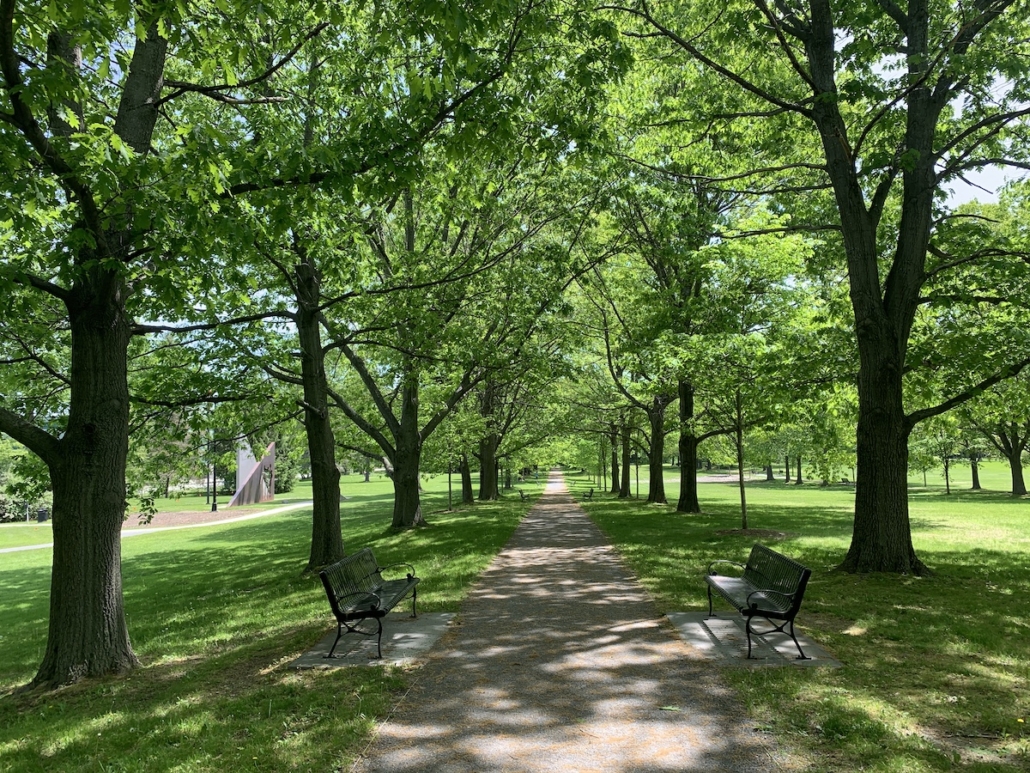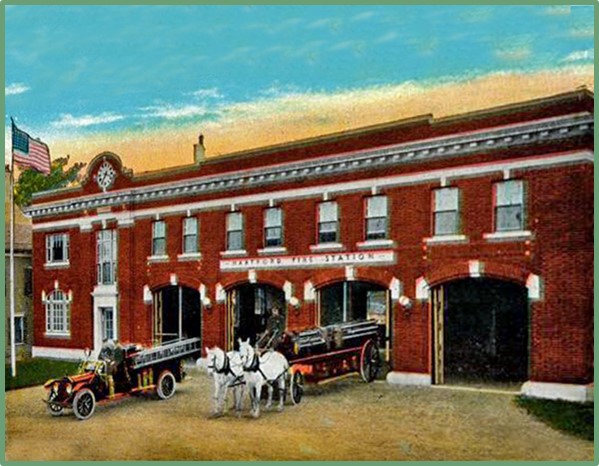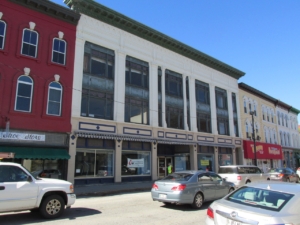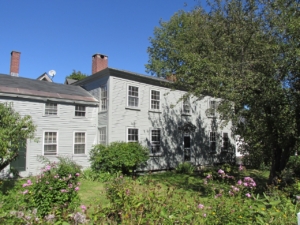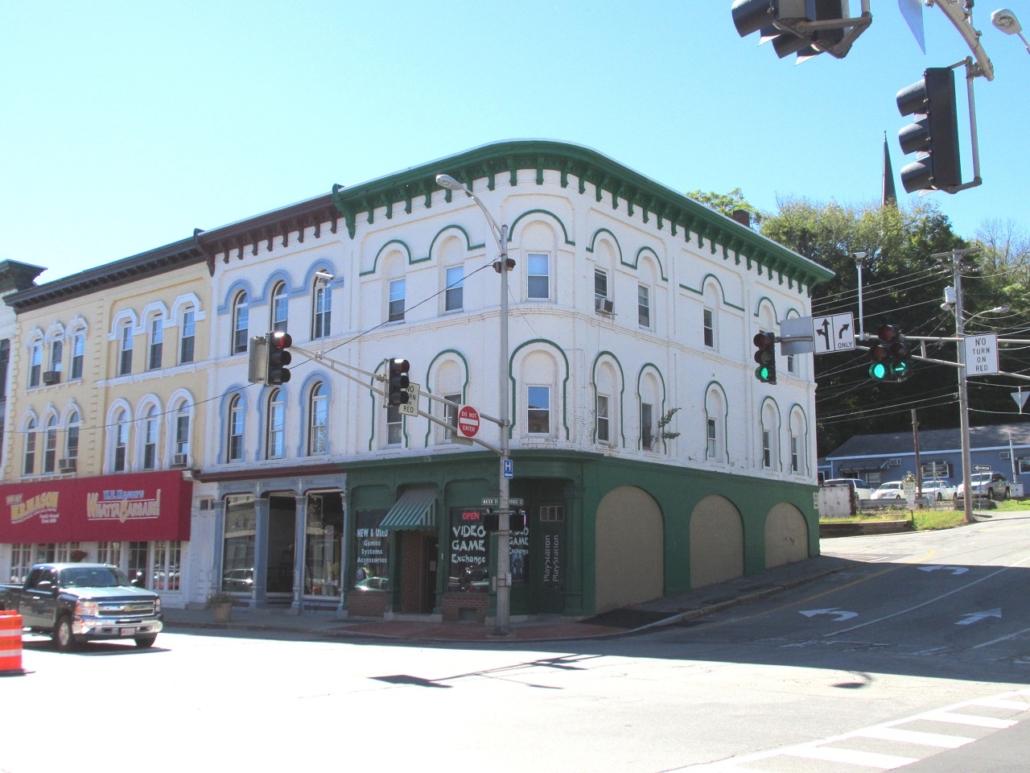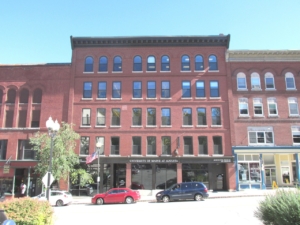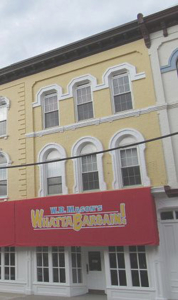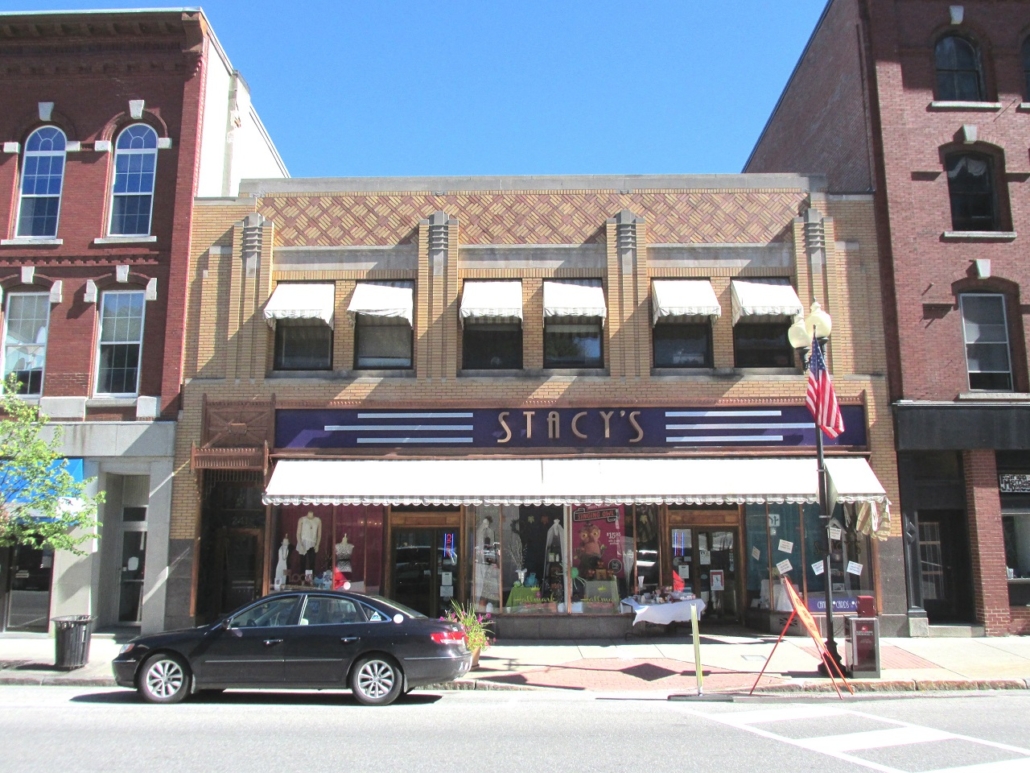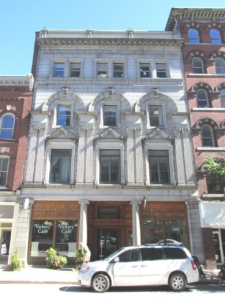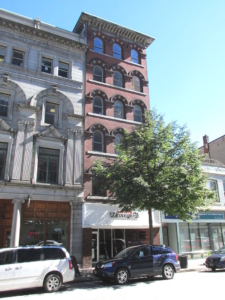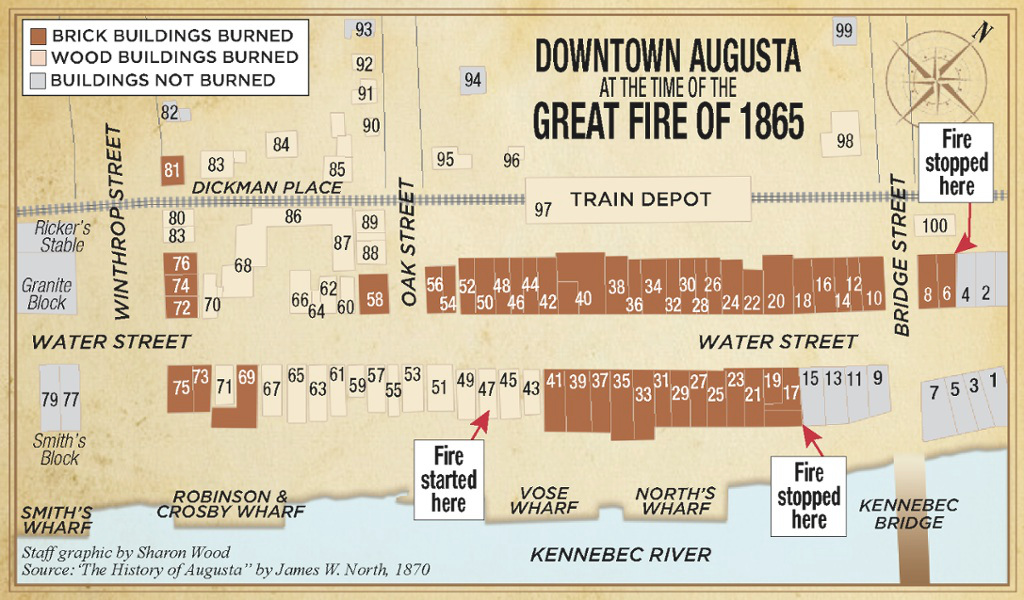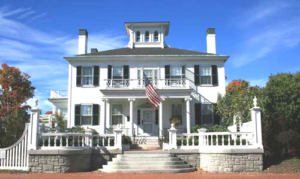Up and down the Kennebec Valley: Historic listings, Augusta Part 9
/2 Comments/in Augusta, Local History, Maine History/by Mary Growby Mary Grow
The Augusta historic district not yet discussed is the Capitol Complex Historic District, added to the National Register of Historic Places in 2001. This district includes several individually listed buildings: the State House, the Blaine House (official residence of Maine’s governors; see the Jan. 21 The Town Line) and the Gannett House, home of the First Amendment Museum (see the Nov. 12, 2020, The Town Line). Other buildings are the Burton Cross Office Building, the Nash School and several 19th-century residences that now house state offices.
Capitol Park, on the east side of State Street in front of the State House, has been listed individually as a historic property since 1989, and is in the Historic District.
After Maine separated from Massachusetts on March 15, 1820, the state capital was in Portland, the largest city. An on-line story by Don Carrigan, of News Center Maine, quotes historians Earle Shettleworth, Jr., and Herb Adams as they explain why and how Augusta succeeded Portland.
Portland had two disadvantages: it was not central, and would become less central as population expanded inland and north; and it was vulnerable to attack from the sea, important when residents still remembered the War of 1812 with Great Britain.
In 1822, Shettleworth said, the legislature established a committee to find a new capital site. Augusta and Hallowell both applied, as did Portland and two other coastal municipalities, Belfast and Wiscasset.
Augusta offered the current site, called Weston or Weston’s Hill; added the land running east to the Kennebec River for a park, for a total of about 34 acres; and offered to contribute toward expenses. After often fierce debates, the legislature voted on Feb. 24, 1827, to make the move, to be effective by Jan. 1, 1832, and on June 6, 1827, the state bought the land.
Legislators also gave Governor Enoch Lincoln and his Council $500 to improve the lot, including planting trees.
Despite the vote and the follow-up actions, the two historians said, every year until 1907 some legislator introduced a bill to return the capital to Portland. On Sept. 11, 1911, voters approved an amendment to the Maine Constitution stating that “Augusta is Hereby Declared to be the Seat of Government of This State.” The vote was 59,678 in favor to 41,294 opposed. The wording is now in Art. IX, Section 16, of the Constitution.
Capitol Park is the earliest of the historic district components. The park is a 20-acre rectangle bounded by State Street on the west, Union Street on the south, the Kennebec River on the east and Capitol Street on the north.
In October 1827 the Council chose General Joel Wellington to design a park plan. In a little over a month, he spent $373.13 of the $500 to create a path from State Street to the Kennebec River. The Maine Historic Preservation Commission’s 1989 application for national recognition (written by historian Shettleworth) describes an 80-foot-wide avenue, with two 30-foot-wide tree-bordered sidewalks.
Shettleworth says Edward Williams, one of Governor Lincoln’s staff, recommended a fence to keep wandering cattle from damaging the new trees.
In 1842, a granite mausoleum was erected near the river for the body of Governor Lincoln (Dec. 28, 1788 – Oct. 8, 1829), who served from Jan. 3, 1827, until his death. The on-line Maine encyclopedia says the tomb has been empty for years, and there is no record of when, why or how its contents disappeared. (See The Town Line, July 9, 2020, for more information on Governor Lincoln.)
By 1851, more trees and paths had been added. The Kennebec and Portland Railroad crossed the east end of the park along the river.
The park’s amenities disappeared during the Civil War. Shettleworth quotes a May 22, 1862, editorial in The Maine Farmer, an Augusta weekly newspaper, listing “tents and stables and barracks” spread through the park and its grounds used for “drills and evolutions.”
After the soldiers went south, the park was leased for farmland, a use The Maine Farmer writer hailed as much more useful than a military encampment. Shettleworth suggests patriotism as the motive.
By 1878, the park was again a park, similar to the 1850s version. In 1920, after James G. Blaine’s daughter donated the Blaine House as the governors’ house, Governor Carl Milliken had the Massachusetts-based Olmsted Brothers do a complete re-landscaping of the State House, the Blaine House and Capitol Park.
Portland landscape architect Carl Rust Parker was in charge of the project. His ambitious multi-year plan included adding three more tennis courts to the existing two; building a “rostrum” in the southwest as the center of an area for concerts and speeches; building a river overlook and nearby pools and a zoo to house Maine fish and land animals; and adding a Maine shrub garden in the northwest.
Shettleworth wrote that legislators were reluctant to appropriate funds for the changes. The fish pools and zoo were never built, and the tennis courts were removed by the 1960s.
The elm trees Parker carefully preserved died of Dutch Elm Disease and were replaced in 1983 with red oaks. The Vietnam War Memorial in the northwest was added in 1985.
The State House, designed by Boston architect Charles Bulfinch and deliberately imitating the Massachusetts State House, is the second early component of the Historic District. It, like Capitol Park, has a separate listing on the National Register of Historic Places, as of April 24, 1973.
The State House was deliberately sited on a high point on the northwest side of the lot donated by Augusta, rather than in the center. Its cornerstone was laid July 4, 1829. Kingsbury says dignitaries at the Masonic-led ceremony included President Andrew Jackson, Vice-President John C. Calhoun and Supreme Court Chief Justice John Marshall.
Construction was supervised by the Commissioner of State Buildings, William King, who had been Maine’s first Governor in 1820. The four-story building was near enough complete for the legislature to meet there January 4, 1832.
The State House is built of Hallowell granite. The original central section, with a cupola and two wings extending north and south, was 146 feet long by 50 feet wide, plus the 80-by-15-foot front portico with Doric columns, according to Richard D. Kelly, Jr.’s 1973 application for National Register of Historic Places listing (Kingsbury offers different dimensions). Wikipedia says it was supposed to cost $89,000; the final cost, including furnishing and landscaping, was $138,991.34, Kingsbury wrote.
As state government grew, the interior was changed in 1852 and 1860, and in 1891 a three-story wing was built on the west side. In addition to offices, it housed the state library, now in the separate Cultural Building with the state archives and museum. The Cultural Building, built in 1967-69, has been closed since late July 2020 for asbestos removal and upgrades to the heating, cooling and electrical systems.
The State House had major exterior remodeling in 1909 and 1910. The Bulfinch front and back and the rotunda were the only things left unchanged, as the building was made 300-feet long by extending the wings and the cupola was replaced by a 185-foot dome.
Massachusetts architect George Henri Desmond designed the changes; Charles S. Hichborn, of Augusta, oversaw the work. Sculptor and Gardiner native William Clark Noble (Feb. 10, 1858 – May 10, 1938) added a 15-foot gilded copper statue of Minerva, Roman goddess of wisdom, on top of the dome.
Wikipedia describes and illustrates the 2014 replacement of the dome’s 1910 copper sheathing (which had been expected to last 75 years). The work took from March to October 2014 and cost $1.2 million. The Minerva statue was regilded and repaired by EverGreene Architectural Arts, a New York City historic preservation firm.
Wikipedia says legislative leaders put a time capsule in the dome with “a book of Maine laws, a legislative handbook, the September 30 [2014] issue of the Kennebec Journal, some of the old copper, and personal items from the legislators.” The dome looks exactly the same since the restoration, except that it is now a copper-brown color instead of oxidized to green.
Kelly wrote that the Maine State House is architecturally significant as Bulfinch’s only known surviving work after he completed the Capitol in Washington in 1829 and came back to the Boston area. It is also significant as the only Bulfinch building for which his original plans are extant; they were found in the lining of a safe in the building in 1941, and as of 1973 were in the Maine State Archives.
The Burton M. Cross Office Building, a multi-story grey rectangular building west of the Capitol and connected to it by a tunnel, was originally the Maine State Office Building. It is steel-framed with a granite exterior.
Portland architects Miller and Beal designed the building in collaboration with a Boston firm. Construction started in June 1954 and was finished in the fall of 1956, historian Shettleworth wrote in his application for national recognition of the Capitol Complex Historic District, making it the youngest building in the District.
The Augusta State Facilities Master Plan, prepared by SMRT Architects and Engineers in August 2001, says the State Office Building was “state-of-the-art” when it was built, and might have been Maine’s biggest office building. In 2001, according to the SMRT website, the building was renovated, resulting in what the website describes as “a contemporary, open-office environment that supports growth in information technologies and telecommunications and leading-edge mechanical, HVAC and electrical and lighting systems to keep employees comfortable and healthy.”
The renovated building was renamed in 2001 to honor Gardiner native, Maine legislator and Maine Governor Burton M. Cross (Nov. 15, 1902 – Oct. 22, 1998). Cross served from Dec. 24, 1952, to Jan. 6, 1953, as Maine’s 61st governor, because he was state Senate President when Governor Frederick Payne resigned to become a United States Senator. In 1952, he was elected Governor. But his Senate term ended 25 hours before his governorship began, so in the interim his successor as Senate President, Nathaniel Haskell, became the 62nd governor. Cross was the 63rd governor from Jan. 7, 1953, to Jan. 5, 1955.
Other buildings in the Capitol Complex Historic District are former residences, some built around the time Augusta became the capital city. Shettleworth’s application lists the Guy P. Gannett House at 184 State Street, built in 1911; the James G. Blaine House at 192 State Street, built in 1833; the Gage-McLean House at 193 State Street, built around 1837; the Arnold-Gaslin House at 189 State Street, built around 1830; the Edward Williams House at 187 State Street, also built around 1830; and the Gage-Lemont House at 55 Capitol Street, built around 1845.
Also part of the complex is the former Nash School, a two-story brick building at 103 Sewall Street, west of the main buildings, that the state bought in 1976.
According to Shettleworth, Augusta architect Arthur G. Wing designed the Nash School in the Romanesque Revival style; L. E. Bradstreet was the builder. On April 7, 1897, the city and the two men signed a contract for $8,973. The building was finished by September 1897.
About the designers of Capitol Park
Capitol Park designer General Joel Wellington was born in 1782 in Massachusetts and moved to Albion, Maine, early in the 19th century. The source of his military title is obscure; Ruby Crosby Wiggin found him listed as a captain in one of Albion’s companies in the War of 1812.
In 1814, Wellington was on the town committee to rebuild the bridge across the head of China Lake (then part of Albion). In October 1819 he was elected to the state convention that approved separating Maine from Massachusetts, and in the new state he represented Albion in the legislature. He was also a town selectman and Albion’s first postmaster, from March 1825 until 1831.
Around 1830, Wellington and George Pond co-founded the town of Monticello, originally called Wellington Township, on the north branch of the Meduxnekeag River, in Aroostook County. The Find a Grave website says Wellington built the road south to Houlton that is now Route 1, and eventually got repaid by the federal government.
Wellington died July 12, 1865, in Fort Fairfield, and is buried in the Village Cemetery, in Monticello. The website says Pond died the same day. It also says Wellington died at his son Albion’s home (and another website says Albion helped his father clear the land for their first log cabin); but on the same page, Find a Grave lists only four descendants: daughters Harriet and Clarissa (named after his wife, Clarissa Blake Wellington [1786-1868]) and sons James C. and George Blake.
Main sources
Kingsbury, Henry D., ed., Illustrated History of Kennebec County Maine 1625-1892 (1892).
Wiggin, Ruby Crosby, Albion on the Narrow Gauge (1964).
Websites, miscellaneous
Up and down the Kennebec Valley: Historic listings, Augusta part 8
/1 Comment/in Augusta, Local History, Maine History/by Website Editorby Mary Grow
Just south of the historic buildings at the north end of the west side of Augusta’s Water Street (described in last week’s article) is a much newer building that gained a place on the National Register of Historic Places on May 2, 1986. The D.V. Adams Co .- Bussell and Weston Building, at 190 Water Street, was built in 1909. Wikipedia calls it “one of the state’s best early examples of a department store building.”
Like its northern neighbors, it is built of brick and three stories tall, but the front has much more window space, particularly on the upper floors. The street level has five separate bays, the center one a recessed entrance.
Wikipedia says Boston architects Freeman, Funk and Wilcox designed the building for Bussell and Weston. Roger Reed, writing for the Maine Historic Preservation Commission, calls the architectural firm Freeman, Frank and Wilcox – Web references do not resolve the discrepancy – and says Bussell and Weston was a dry goods company.
The original building had what Wikipedia calls a stepped parapet. On-line photos show stepped parapets having more than one level, as the name suggests. Reed wrote that the present Italianate cornice, similar to but elevated slightly above its neighbors, replaced the original sometime between 1912 and 1920.
One on-line source calls the architectural style Classical Revival, and others mention the Chicago style windows on the upper floors. Reed says Bussell and Weston intended, and their architects achieved, a building that would stand out from its neighbors.
In 1920, department store founder and owner Delbert W. Adams bought the Bussell and Weston building and contents and moved from his 1910 store on the east side of Water Street. His store closed in 1982, according to Augusta’s on-line Museum in the Streets; Reed’s report says a department store used the building until 1985. The name change from D. W. Adams to D. V. Adams is nowhere explained.
In 1985, Reed listed the building owner as G. T. G. Association. His description commented on the unchanged interior space, “complete with iron columns, wooden staircase and pressed metal ceiling.”
While on Water Street, it seems appropriate to describe the Hartford Fire Station, although at 369 Water Street it is south of the boundary of the Water Street historic district that this series has covered beginning with the Feb. 4 The Town Line piece.
The station’s alternate address is 1 Hartford Square. It is southeast of the south end of Water Street, with Gage Street on the northeast and the backs of the buildings lining Swan Street on the southwest. Built in 1920, the Hartford Fire Station was added to the National Register of Historic Places in 2017, as a $6 million addition and renovation project was under way.
The large two-story brick building was designed by local architects Bunker and Savage, established in 1916 and still in business. An on-line Maine Preservation article calls its style Classical Revival.
The same article says the name recognizes George Huntington Hartford, whose son donated the land for the building.
George Huntington Hartford (Sept. 5, 1833 – Aug. 29, 1917) was born on an Augusta farm. By the time he was 18, he was in Boston starting a career in retail businesses. In 1861 he was in Brooklyn, New York, where he was hired as a clerk in George Gilman’s Great Atlantic and Pacific Tea Company.
Wikipedia says Hartford moved up in the firm until he became a partner when Gilman retired in 1878 and effectively ran the company until Gilman died in 1901. After Gilman’s death, Hartford bought out his heirs and ran what was by then A & P until his own death, though two of his sons took over day-to-day management in 1907 or 1908. Hartford invented the idea of a chain of grocery stores, and before he died he and his sons made A & P the largest retailer in the United States.
The 1920 Hartford fire station was the first in Augusta to have a fire horn that could signal fire locations to everyone in the city, and the first to be designed to accommodate motorized as well as horse-drawn fire equipment.
As fire trucks became larger and heavier, the station ran out of space and the floors began to deteriorate. In 2016, work started on an addition, plus repairs and interior remodeling of the original building. The on-line Maine Preservation article lists many people responsible for the successful project, including Fire Chief Roger Audette and Sutherland Conservation and Consulting (SCC), of Augusta.
SCC was founded in 2007 by Amy Cole Ives, of Hallowell, who previously spent eight years working for the Maine Historic Preservation Commission. In May 2008, the SCC website says, Maine Historic Preservation gave her a Statewide Historic Preservation Honor Award for her role in promoting legislation that led to the state’s Tax Credit for the Rehabilitation of Historic Properties and the Maine Uniform Building and Energy Code (MUBEC).
Ives’ specialty is analysis of historic paint and other finishes on buildings, vehicles and art works. In March 1917 she helped organize the sixth International Architectural Paint Research (APR) Conference at Columbia University in New York City. She also presented a paper there.
(The third APR conference was in January 2008, also at Columbia University. The fourth was in 2010, in Lincoln, in the United Kingdom. The fifth was in March 2014 in Stockholm, Sweden. The seventh was scheduled for Tel Aviv University, Israel, in October 2020, and was retitled, more broadly, the Architectural Finishes Research Conference. It was rescheduled to a January 2021 virtual conference.)
In October 2020, Ives announced that SCC was absorbed by MacRostie Historic Advisors (MHA), LLC, with at least one employee joining MacRostie’s Boston office. Ives planned to continue consulting on historic paint.
The statement that Augusta has four designated historic districts that opened the Feb. 4 article was an error by this writer. The city has five designated districts: the Water Street commercial district that has been described; the Capital District around the State House on State Street, to be described in the next article; and three residential districts, Bond Street, Crosby Street and Winthrop Street.
The residential historic districts contain mostly private houses that are not open to the public. Should readers care to visit them, owners’ rights and privacy are to be respected.
Bond Street is a short street that connects State and Water streets, just south of Bond Brook. The historic district includes seven one-and-a-half story wooden residential buildings, numbers 8, 9, 12, 18, 21, 22 and 25. All were built between 1878 and 1884 by Edwards Manufacturing Company to house employees in its textile mill. The company sold them to private owners in 1946.
Wikipedia says there are two four-unit buildings and a single-family house on the north side of Bond Street and four duplexes on the south side. All are similar in style. In 1900, the census found 167 people in 20 families living in the buildings.
Although other Augusta mill owners provided employee housing, Wikipedia says the Bond Street buildings are the only ones still standing in the city. The historic district was listed on April 11, 2014.
Crosby Street is a dead-end street south of and uphill from Bond Street. It runs north off Bridge Street, parallel to State Street above it and roughly parallel to Water Street below it. Crosby Lane connects the middle of Bond Street to State Street.
The Crosby Street historic district, listed Sept. 11, 1986, encompasses eight houses: one on State Street, one on Crosby Lane and six on the south end of Crosby Street. These are elegant, stylish homes, the earlier ones Federal and the later Greek Revival style, and would have been built for business and professional men.
The large two-story Federal George Crosby House at 22 Crosby Lane, with a story-and-a-half ell almost as big, is the oldest of the seven, Wikipedia says. Built around 1802 for businessman George Crosby, it was followed about 1806 by a similar house next door built for John Hartwell, described as a carpenter and auctioneer.
A Maine Historic Preservation Commission piece quoted online says the two houses have doorways designed from the1797 “Country Builder’s Assistant”, by Asher Benjamin, one of many architectural plan books that helped builders in places like Maine follow national style trends.
The Crosby house was the home of Governor Samuel Smith from 1832 to 1834. His choice led to additional generously-sized houses built by Eben Fuller and William Hunt, among others.
George Crosby is listed in Captain Charles E. Nash’s chapters on Augusta in Kingbury’s Kennebec County history as the first cashier of the Augusta Bank, chartered Jan. 21, 1814.
John H. Hartwell was born in Lincoln, Massachusetts, Jan. 2, 1787. He married Eliza Brooks (1789-1864) on May 31, 1810, in Hallowell, and they had two sons and six daughters. He died March 6, 1859, in Augusta.
Nash wrote that Eben Fuller (Jan. 25, 1795 – Oct. 7, 1873) opened the Fuller drug store in 1819. The building burned in the September 1865 fire, and Eben and his only son, Henry Lucius Fuller (1827-1875), rebuilt it. Eben Fuller married Eliza Williams (1799-1883); they had one son and four daughters.
The Winthrop Street historic district is the largest of the three residential districts, covering about 100 acres. When the district was designated on Aug. 6, 2001, it included 192 buildings on Chapel, Chestnut, Court, Green, State and Winthrop streets. On Dec. 30, 2008, Wikipedia says, the district boundary was expanded to add the 1830s Federal house at 20 Spring Street.
Winthrop Street runs approximately west from Water Street to the Augusta airport. It separates Mount Hope Cemetery on the north from Forest Grove Cemetery on the south.
Some of the earliest houses in the historic district date from 1815 or before. Most were built between 1830 and 1850, after the state capital was moved to Augusta by law in 1827 and, in fact, in 1832. New houses continued to be built for residents involved in Augusta’s publishing (see The Town Line, Nov. 12, 2020) and manufacturing enterprises until around 1915.
Non-residential buildings include Lithgow Library, the Kennebec County Courthouse, at 95 State Street (see Jan. 7; the Lot Morrill house on Winthrop Street described there is also inside the historic district) and two churches. A variety of architectural styles are represented, with Federal, Victorian and Colonial Revival dominant, Wikipedia says. Some of the former residences now house professional offices.
NOTE ON SHURTLEFF HOUSE
Readers who planned to look at the Shurtleff House, on Route 201, in Winslow, (see The Town Line, Jan. 28, 2021) will not find it. Michael Fortin, owner of Fortin’s Home Furnishings, on the east side of Route 201, said when the property went up for sale, he bought it because he owned adjacent land. When he inspected the neglected house, he found it was “far beyond repair” and, with regret, had it demolished on Feb. 19, 2021.
Main sources
Kingsbury, Henry D., ed., Illustrated History of Kennebec County Maine 1625-1892 (1892).
Websites, various
Next: Augusta’s Capitol Complex Historic District.
Up and down the Kennebec Valley: Historic listings, Augusta Part 7
/0 Comments/in Augusta, Local History, Maine History/by Website Editorby Mary Grow
The east (river) side of Augusta’s Water Street has another individually-listed 19th-century historic building besides those described in The Town Line articles published Feb. 4 and Feb. 11. The 1899 five-story brick building at 325-331 Water Street was first known as the Gannett Building, later as the “Journal” Building and now as the University of Maine at Augusta’s (UMA’s) Handley Hall.
The Gannett Building was presumably named for Augusta publisher William Howard Gannett (1854-1948), who published magazines in Augusta beginning in the mid-1880s (see The Town Line, Nov. 12, 2020). It was designed by Arthur G. Wing, described in Wikipedia as a local architect who died in 1912; this writer found no additional on-line information about him.
Wikipedia calls the style commercial Renaissance Revival. There are three street- level store fronts and above each four stories with three windows each, the whole topped by a cornice. The windows have granite sills; the most conspicuous arches are on the fourth floor.
According to Wikipedia, this building was the first owned, as opposed to rented, home for Augusta’s Kennebec Journal newspaper. Often described as Maine’s oldest continuously published newspaper, the Kennebec Journal began in January 1825 as a four-page weekly produced by Russell Eaton and Luther Severance.
Augusta became Maine’s capital in 1827, and after state government became established in 1832 the Kennebec Journal gained importance and a new revenue source. It became a daily paper on Jan. 1, 1870.
Various people owned the newspaper in the 19th century. The Gannett family was not involved until mid-1929, when William Howard Gannett’s son Guy P. Gannett (1881-1954) added it to the Gannett Publishing Company papers.
A Jan. 8, 2015, Kennebec Journal article by Craig Crosby on the 190th anniversary of the newspaper says the younger Gannett moved headquarters to a Willow Street building his father had previously owned. Apparently the move was soon after the June 1929 purchase. Crosby fails to say where the move was from, leaving uncertain the date the Journal left what was presumably by then called the “Journal” building.
At another unstated time the University of Maine at Augusta bought the building and contracted with WBRC Architects Engineers to change it from office space into art and architecture teaching areas, with a ground-floor gallery. A WBRC web page shows the exterior, labeled Gannett Building, and says interior work included undoing earlier changes to uncover “wooden beams, punched tin ceilings, masonry walls and wooden floors.”
(According to its website, the WBRC firm was founded in Bangor in 1902 by two young University of Maine engineering graduates named John F. Thomas and C. Parker Crowell; the firm was Thomas and Crowell. Thomas soon moved to Massachusetts; Crowell stayed with the firm for the next 54 years, with its name changing as partners joined and left.
The ninth name, in 1987, was the longest: Webster/ Baldwin/ Rohman/ Day/ Czarniecki. By 1989 Day had left and Bromley and Rich had joined; the new group chose the initials WBRC, and so far no one has changed it. WBRC has branches in Portland, Maine, and in Florida, Maryland and Michigan.)
UMA gave the building its third name, Handley Hall, in honor of UMA’s first female president, Allyson Handley. She took office on March 1, 2008, at the age of 60, and held the post for six years.
A 2018 announcement of her becoming president of the Johns Hopkins Alumni Association says UMA was the third college she served as president. It credits her with changing UMA’s undergraduate architecture program to “a four-year, accredited architecture degree,” giving graduates a head start in the profession.
The “Journal” building was added to the National Register of Historic Places on May 2, 1986, at the same time as the buildings described below and the Kresge and Doughty blocks and the Masonic Temple discussed in the Feb. 11 issue of The Town Line.
On the inland (west) side of Water Street, starting at the north end, listed buildings include a four-building block built after the 1865 fire described in the Feb. 4 The Town Line article. They are the Sturgis and Haskell Buildings, 180-182 Water Street, and the Noble Block, 186 Water Street, both built in 1867; and the Whitehouse Block at 188 Water Street, built in 1865 (since the fire was in September 1865, it must have been constructed in a hurry).
The brick buildings are three stories tall, in the commercial Italianate style, and connected by a cornice. The northern two are off-white with two different types of blue window trim, the southern two yellow with white window trim. The style of window trim varies not only from building to building but between second and third floors on each building.
Each separate building would have a single street-level entrance and triple windows on the second and third floors, except that the northernmost, and last finished, Sturgis and Haskell Building has a rounded corner as it fronts the intersection where Bridge Street comes downhill to meet Water Street. There are only two east-facing windows on the upper floors overlooking Water Street; the third windows face northeast from the rounded corner.
Architect John C. Tibbetts, of Augusta, designed the double building for Ira Sturgis and Erastus Haskell. A 1985 Maine Historic Preservation Commission inventory says the original cast-iron store fronts at sidewalk level remained, but with larger-paned windows. Arches above the windows at 180 Water Street had been filled in to make the windows square-topped. The building at 180 was then owned by Carrie Chan and 182 by Peder K. Baughman.
Tibbetts also designed the Noble Block next south, for Thomas C. Noble. Wikipedia says the first story of the Noble Block was finished in 1865 and the upper floors in 1867.
Portland-based architect Francis H. Fassett, whom readers met before as designer of the Williams Block on the east side of Water Street (see the Feb. 4, The Town Line) designed the southernmost and first-built of the four buildings for Owen C. Whitehouse. Before the fire, Whitehouse had his dry goods store on the same site. In the new building, Wikipedia says Whitehouse’s dry goods store was on the second floor; street-level tenants included “Augusta Savings Bank and the United States Pension Agency.” Fraternal organizations, unspecified, used the top floor.
Augusta 19th century businessmen Ira Sturgis, Erastus Haskell, Thomas Noble and Owen C. Whitehouse
The quantity and quality of information in readily available sources about Ira D. Sturgis, Erastus Haskell, Thomas C. Noble and Owen C. Whitehouse varies.
Ira Daggett Sturgis (1814 or 1815 -1891), oldest son of James and Nancy (Packard) Sturgis, was a Vassalboro farmer turned lumber baron whose family began operations in The Forks, farther up the Kennebec River, in the 1830s.
An on-line history called Canada Road Chronicles (hereafter Chronicles) says in 1835, Sturgis married Augusta native Rebecca Russell Goodenow (1815-1894). They had four children; the older boy was named Ira.
During the 1840s and 1850s, Sturgis and a half-brother ran water-powered sawmills in Vassalboro, and he bought large tracts of timberland in the northern Kennebec Valley. Captain Charles E. Nash, author of the chapters on Augusta in Henry D. Kingsbury’s Kennebec County history, says Sturgis’s factory on Seven Mile Brook, in Vassalboro, built wooden items, including “the first orange and lemon boxes ever exported from the state of Maine.” His nearby shipyard built ocean-going vessels.
Sturgis shifted his interest to Augusta briefly; spent the late 1850s and early 1860s in the lumber business in Aroostook County and New Brunswick; and returned to Augusta.
In 1867, Chronicles says, the younger Sturgis daughter, Sarah Elizabeth, married Josiah Manchester Haynes, of Waterville. Sturgis and Haynes promptly formed the Augusta-based Kennebec Land and Lumber Company, with Sturgis president and Haynes treasurer. A more recent on-line source, A Capital Happening (hereafter Happening) on Facebook, dates this company to 1861. Happening and Nash name Albert Daily as Sturgis’s partner.
Nash says Sturgis made production of steam power cheaper by using sawdust as fuel. A second steam-powered mill in Pittston was soon accompanied by a modern ice house. Sturgis established the connections that made Kennebec River ice familiar in major cities in the southern United States (see the May 14, 2020, The Town Line for more information on ice harvesting on the Kennebec).
In February 1870 a flood washed away a substantial part of the Augusta dam, the fourth time it had been damaged since it was first built in 1837. Sturgis oversaw its reconstruction in July 1870, supervising engineer Henry A. De Witt and the work crews.
Haynes became Land and Lumber Company president in 1875, according to Chronicles; Happening and Nash say the lumberyard burned in October of that year. Both agree Sturgis and another Augusta businessman named Thomas Lambard formed Sturgis, Lambard and Company (in 1876, according to Happening; Chronicles and Nash add Sturgis’s nephew, Ira Randall, as a third partner). That company became Augusta Lumber Company (in 1889, according to Happening); Sturgis was its president until his death. Augusta Lumber Company appears to have remained in business until it was sold in 1941.
Erastus Haskell (1815 – 1891 or 1892), was born in Winthrop. He learned the shoe trade in Waterville and worked in East Vassalboro for three years, moving to Augusta Dec. 1, 1840. Before the 1865 fire, he ran a shoe store on the east side of Water Street, in one of the buildings that burned. The New England Business Directory lists him as an Augusta boot and shoe dealer in 1883 and in 1889.
Haskell served as a City of Augusta assessor for three years, and “served three years in each of the branches of the city government,” according to Nash. He married Mary C. Williams; they had two sons and daughter. Haskell died in Augusta and is buried in Mount Pleasant Cemetery.
An on-line genealogy lists Thomas Chadbourne Noble, who was born in Portsmouth, New Hampshire, on August 24, 1807; married Adeline Treby Johnson (1817-1901); and died Feb. 5, 1901, in Augusta. They had four boys and one girl; the second boy was Thomas Chadbourne Noble (1846-1890).
Another genealogy includes Thomas C. Noble of Augusta, born in 1845, who married Edith Goddard on Jan. 22, 1880. He died in 1889 and she remarried.
Probably the Thomas C. Noble who was eager to have a new building in 1865 was the older, who would have been 58 by then, rather than his son, barely 20.
Owen C. Whitehouse was one of nine children of Vassalboro residents Daniel Whitehouse, Jr., and Merab (Coleman) Whitehouse. With his older brother Seth he went into the dry goods business in Augusta in 1846. The S. C. and O. C. Whitehouse company “did a large and successful business,” Nash wrote.
Whitehouse had other business interests besides dry goods. A 50th anniversary history of Augusta Savings Bank, founded Aug. 10, 1848, lists him as added to its incorporators in 1852. When the 1833 Freeman’s Bank was reorganized on April 6, 1864, as Freeman’s National Bank, he was one of the directors. The 1877 Maine Register shows him as a dealer in wool and skins at an unspecified Augusta location and a seller of flour and grain on Water Street.
Whitehouse also served his city. Annual reports show he was a fence viewer and a tythingman in 1870-71, and an overseer of the poor in 1883. (Tithingman is the modern spelling, and the term, originally related to keeping order in church, by the 1870s probably referred to a local constable.)
Main sources
Kingsbury, Henry D., ed., Illustrated History of Kennebec County Maine 1625-1892 (1892)
Websites, various
Next: still more of Augusta’s historic buildings.
MaineGeneral Health opens new practice
/0 Comments/in Augusta, Community, Waterville/by Website Editor MaineGeneral Health has announced the opening of a new medical practice, MaineGeneral Addiction Medicine on Feb. 1, 2021. Addiction Medicine will provide comprehensive services to patients seeking treatment for substance use disorder, opiate use disorder and the treatment of other addictive substances. Services are offered at two locations, 9 Green Street in Augusta and Thayer Center for Health in Waterville.
MaineGeneral Health has announced the opening of a new medical practice, MaineGeneral Addiction Medicine on Feb. 1, 2021. Addiction Medicine will provide comprehensive services to patients seeking treatment for substance use disorder, opiate use disorder and the treatment of other addictive substances. Services are offered at two locations, 9 Green Street in Augusta and Thayer Center for Health in Waterville.
MaineGeneral’s Addiction Medicine team uses an evidence-based approach to manage opioid, alcohol and stimulant and sedative (benzodiazepine) use disorders, with a focus on diagnosis, treatment and prevention. “From one-on-one appointments with addiction medicine physicians, to group meetings, individual counseling and needle exchange services, we are here to support patients and families through this process,” said Nicholas Gallagher, DO, medical director.
“MaineGeneral looks forward to providing more robust substance use disorder treatment services to our community,” said Chuck Hays, president/CEO. “For the last 15 years, we have provided medication-assisted treatment for opiate use disorder. Having an Addiction Medicine practice allows us to continue to effectively respond to the current opioid crisis in our community, as well as the ongoing prevalence of alcohol use disorder and its long-ranging effects on individuals and families.”
To learn more about MaineGeneral Addiction Medicine, please call 872-4151 or 207-621-3759 or visit http://www.mainegeneral.org/addiction-medicine.
Up and down the Kennebec Valley: Historic listings, Augusta Part 6
/0 Comments/in Augusta, Local History, Maine History/by Mary Growby Mary Grow
Last week’s exploration of Augusta’s Water Street Historic District talked about the designated historic buildings on the northern half of the east (river) side of the street. This article will continue south along the river.
The Kresge Block at 241-249 Water Street is the newest of the Water Street buildings that rate individual Historic Places recognition. It was built in 1932 for S. S. Kresge’s five and dime store (which Wikipedia calls a department store).
(Sebastian Spering Kresge [July 31, 1867 – Oct. 18, 1966] was a Pennsylvanian who founded the S. S. Kresge chain of discount stores and the Kresge-Newark department stores. Bowdoin College’s Kresge Auditorium is named in his honor. The S. S. Kresge stores became Kmart in 1977.)
Before the Kresge Block, Augusta’s Museum in the Streets on-line brochure says, an Italianate building on the site housed Dirigo Business School, identified in 1886 as Dirigo Business College, which opened in 1867 and operated from various locations. An online source calls it a two-campus school when it lost accreditation and closed in 2003.
Wikipedia calls the Kresge Block “a distinctive and rare local example of commercial Moderne architecture.” The Museum in the Streets uses the term “Art Deco.”
Although built of the same brick and granite as its neighbors, the Kresge block stands out. It is only two stories tall, and its tan-colored bricks contrast with the reddish ones on either side. Between the second-floor windows, which are rectangular without arches, elegant three-piece pilasters rise to a flat front with, per Wikipedia, “a multicolor crosshatch brick pattern.”
The ground floor has a double storefront, metal-bordered windows (some sources call the borders bronze, others copper) and on the north end an entrance to the second floor with a metal hood above it. Professional offices occupied the second floor in the 1930s.
The Museum in the Streets says the Kresge store opened in a 4,500-square foot space. Amenities included “mahogany counters…and a modern soda fountain.”
In 1978 or 1979 Richard Cummings bought the building, which then housed a Jupiter Discount Store. He moved Stacy’s, the Hallmark stationery store he had opened in 1973 and named for his daughter, Stacy Gervais, into the ground floor. In 2007, the family restored the front of the building to its 1932 look.
A Dec. 14, 2015, Kennebec Journal article by Jessica Lowell announced the store’s closing at the end of the year, after almost 43 years in business. The article said Augusta developer Tobias Parkhurst would buy the Kresge Block in January 2016 and planned to rent two second-floor apartments and two separate ground-floor retail spaces.
Lowell’s article quoted Parkhurst and others involved in real estate who said the market for downtown buildings has turned upside down as shoppers drive to suburban malls and strips. In areas like Augusta’s Water Street, street-level retail spaces have lost value, while upper-floor office space and apartments are sought after.
The Kresge Block was added to the National Register of Historic Places on May 2, 1986.
Continuing south, the Vickery Building at 261 Water Street is another granite building, like the Libby-Hill Block described in the immediately previous article (see The Town Line, Feb. 4). Designed by John C. Spofford, it was built in 1895 to house Peleg O. Vickery’s printing and publishing business (see The Town Line, Nov. 12, 2020, p. 10).
John Calvin Spofford (Nov. 25, 1854 – Aug. 19, 1936) was born in Webster, Maine. (The 1886 Maine Gazetteer describes Webster, incorporated in 1840, as the town immediately east of Lewiston, also bounded by Wales, Litchfield, Bowdoin and Lisbon. After some boundary changes with its neighbors, in 1971 its name also changed; instead of honoring statesman Daniel Webster of New Hampshire, it now honors Anasagunticook Chief Sabattus.)
Spofford’s training and career were primarily in the Boston area, but he designed buildings in Bangor, Belfast and Lewiston as well as Augusta. In 1890 and 1891 he designed the first addition to the Maine State Capitol.
The Vickery Building is four stories tall. As described in Wikipedia, it is in Italianate commercial style, with Ionic columns on each side of the recessed street-level door; elaborately trimmed windows on the second and third floors; and smaller fourth-floor windows topped by more trim and a parapet.
The Vickery Building was used commercially for most of its existence. The 1915 Maine Register contains an advertisement for C. E Downing Insurance in the Vickery Building. A May 5, 2020, Kennebec Journal article, again by Jessica Lowell, says until it went up for sale sometime before 2017, occupants included medical offices, the Vickery Café, the Children’s Discovery Museum and a drugstore.
In 2017, Andrew LeBlanc and Jonathan Miller, partners in Mastview Development, bought what Lowell describes as four adjoining buildings and began converting them into apartments. The new Vickery has 23 one- and two-bedroom apartments, she wrote, with monthly rents from $1,000 to $2,100.
She quotes LeBlanc and Miller as saying they want to preserve the historic exterior appearance of Water Street while providing comfortable modern living spaces that they expect will attract residents of varied occupations and income levels.
The Portland Builders website gives the building address as 257-271 Water Street and says a historic preservation grant helped create 13 of the apartment units. More information about the Vickery apartments is available on line at www.thevickery.com.
The 1895 Vickery Building was added to the National Register of Historic Places on March 22, 1984.
Immediately adjoining the Vickery Block, and if the address on the Portland Builders website is correct incorporated into the contemporary Vickery, is the Doughty Block at 265 Water Street. Built in 1890, it is the only six-story building in downtown Augusta. With only three windows across its façade, it is narrower as well as taller than its neighbors.
The exterior is brick, with arches over the windows, five horizontal stone bands separating the floors and a conspicuous cornice extending its flat roof. The online Maine encyclopedia calls its design “somewhat odd”; Wikipedia says it combines Italianate architect, by 1890 going out of style, with Renaissance, just coming into fashion.
The owner was Charles Doughty. The designer was Charles Fletcher, described by Wikipedia as “a prominent local builder.”
Captain Charles E. Nash, author of the chapters on Augusta history in Henry Kingsbury’s Kennebec County history, says Charles F. Fletcher was born on Church Hill in northeastern Augusta in 1846. He began his career as a builder in 1873, and in 1889 partnered with George C. Robbins, of Sidney.
Church Hill was named for Samuel Church, who migrated from Connecticut to Maine around 1780 and settled in Augusta in April 1800. The contemporary Church Hill Road is on the east side of the river and runs north from Route 3 into southwestern Vassalboro.
The Doughty Block, like the Kresge Block, was added to the National Register of Historic Places on May 2, 1986.
Continuing south past the intersection of Water, Winthrop and Front streets, the Masonic Hall at 313-321 Water Street is another of John Spofford’s designs. Wikipedia calls it “a restrained interpretation of the Renaissance Revival.”
The 1894 building is four stories high and has enough street frontage to allow for five separate retail areas. Built of red brick, it has an arch over the center entrance and more arches over the top-floor windows, which are connected to the third-floor ones by brick columns.
In 1970, George R. Caswell wrote a history of the building and some of its occupants. The Maine State Library’s copy is available online.
Caswell’s sources included a June 14, 1915, speech by Henry E. Dunnock in observance of the Trinity Commandery’s 50th anniversary and a Jan. 18, 1919, speech to the Abnaki Club, by Lewis A. Burleigh. According to them, the building was the fifth permanent home for Augusta Masons (the third was a victim of the 1865 fire [see The Town Line, Feb. 4], and the organizations met in temporary quarters in an attic for a few months).
Caswell credits Herbert M. Heath for the hall and for founding the Abnaki Club. On May 14, 1894, Heath created the Masonic Building Association, with $40,000 in capital and a board of directors consisting of five members from each of four Masonic groups: “Bethlehem and Augusta Lodges, Cushnoc Chapter # [,] Trinity Commandery and 103 Masons.”
The Association paid Edwin C. Burleigh, Thomas H. Lang and Eugene Whitehouse $9,000 for the Water Street lot and hired Spofford to design the building. On June 14, 1894, they held a cornerstone-laying ceremony that began with a 500-person parade, reviewed twice by Governor Henry B. Cleaves and the Grand Master of the Grand Lodge of Maine, Horace H. Burbank.
The parade stopped at the corner of State and Winthrop streets, where Burbank laid the cornerstone for Lithgow Library (to be discussed later in this series). The marchers continued downhill to Water Street, where Burbank and other dignitaries laid the cornerstone for the Masonic Hall.
Caswell includes a list of the cornerstone’s contents. Among them were documents relating to the Masonic lodges, lists of 1894 state and city officials, two pictures of wooden buildings that had previously occupied the site, a photograph of Spofford and copies of the June 14, 1894, issues of the Kennebec Journal, Maine Farmer and New Age, Augusta’s three newspapers of the time.
The Masonic Temple was dedicated on April 18, 1895, the first day of a five-day Great Masonic Fair that raised more than $5,000 toward furnishing the new temple.
Caswell found Abnaki Club records showing the organization spent almost $4,000 on its rooms, which included a smoking room, a billiards room, an Octagon Room, a parlor and a cloakroom and passageway. One expenditure was to have the word “Abnaki” in a panel in the floor outside the Octagon Room; the passage and room floors and the panel were all made of oak. By the time Caswell wrote, the wood – and the word – were hidden under linoleum.
The Masonic Hall, now listed online as Bethlehem Lodge, at 317 Water Street, was added to the National Register of Historic Places on May 2, 1986, at the same time as the Kresge and Doughty blocks.
Main sources:
Kingsbury, Henry D., ed., Illustrated History of Kennebec County Maine 1625-1892 (1892).
Websites, miscellaneous
Next: still more historic buildings on Water Street, in Augusta
Area students give to those in need
/0 Comments/in Augusta, Community, School News/by Website EditorPart of the mission of Maine Catholic schools is to accentuate the importance of service with the hope of building a lifelong commitment and appreciation in each student to give back to those in need. Last week, that lesson was on full display at schools across Maine during Maine Catholic Schools Week as students designed and completed many service projects to help local organizations
St. Michael School, Augusta
The students at St. Michael School collected hundreds of school supplies for refugee children in Maine that are served by Catholic Charities Maine’s Refugee and Immigration Services (RIS). Each grade was assigned different items to donate like crayons, books, toys, construction paper, chalk, erasers, water bottles, calculators, binders, pencil cases, folders, and markers.
“In completing the service projects, the students are learning service to others while demonstrating the values and faith they are getting in a Catholic education,” said Kevin Cullen. “To see the children so excited to give back is beautiful. They did a fantastic job, as always. I’m very proud of them.”
Mount Merici Academy, Waterville
The academy hosted a donation drive to help those in need at the Mid-Maine Homeless Shelter by collecting tissues, toilet paper, razors, shaving cream, toothpaste, shampoo, conditioner, deodorant, soap, and socks. The items were used to assemble personal care kits for shelter residents.
Augusta educator named Maine Catholic schools teacher of the year
/0 Comments/in Augusta, Community, School News/by Website Editor
From left to right, St. Michael School Principal Kevin Cullen, Diocese of Portland Bishop Robert Deeley, Maine Catholic Schools Teacher of the Year Jennifer Hoffman. (photo courtesy of Diocese of Portland)
“In January of 2019, I was diagnosed with Stage 4 cancer for the second time. This would require a major surgery and brutal treatments which would last at least two years,” said Kevin Cullen, principal of St. Michael School, in Augusta. “Someone needed to step up, and for us at St. Michael School, it was Jennifer Hoffman.”
English teacher, vice principal, and advisor are just a few of the many titles that Jennifer Hoffman successfully holds at St. Michael School, earning her the respect and reverence of the students, teachers, families, and staff.
On Friday, February 5, she added another: 2021 Maine Catholic Schools Teacher of the Year.
Bishop Robert Deeley, along with Marianne Pelletier, the superintendent of Maine Catholic Schools, and Fr. John Skehan, pastor of St. Michael Parish, in Augusta, presented the award to Mrs. Hoffman during a surprise assembly that included a tribute video featuring the glowing and loving remarks of her students.
“She cares about all of her students, and I love being in her class,” said one boy student.
“She is always willing to help us, and she is always happy,” added a girl student.
Moments later, the students rose to offer a standing ovation to Mrs. Hoffman as she was called to the front of the assembly held in the socially distanced school gym.
“I had no idea what was happening. I can’t believe it,” she said. “Wow!”
Bishop Deeley presented her with two special plaques marking the occasion, one for the school and one for Mrs. Hoffman that, fittingly, featured an apple for the teacher.
“In addition, Mrs. Hoffman receives $500 for her classroom, and $500 for herself,” said Pelletier, as Mrs. Hoffman was given bouquets of flowers by Cullen and her husband, who was in attendance along with her sister and son, Noah.

Maine Catholic Schools Teacher of the Year Jennifer Hoffman, left, receives the award from Bishop Robert Deeley at a recent assembly held at St. Michael School, in Augusta. (photo courtesy of Maine Diocese of Portland)
“You are outstanding at what you do,” added the bishop. “I’m so grateful for Mrs. Hoffman and all of our Catholic school teachers.”
Credit is something that Mrs. Hoffman is never quick to accept, the ‘downside’ of being one of the most humble and kind people to ever grace the halls in the nearly 130-year history of Catholic education in Augusta.
Which brings us back to Kevin Cullen, who, during the course of cancer treatments, was put on bed rest for almost four months, forcing him to miss graduation, enrollment efforts, report card creation, and tours for prospective families.
“In Catholic schools, we don’t have someone to step in because we do not have money for that,” said Cullen. “This was going to require our best full-time teacher to also be the full-time principal.”
Mrs. Hoffman maintained her full schedule of teaching junior high classes while assuming the additional duties of overseeing the entire school. She did it, to no surprise, with empathy and aplomb.
“She has worked for Catholic schools in Augusta for more than 25 years, the last 13 at St. Michael, and she is the walking embodiment of what a Catholic school educator needs to be in the 21st century,” said Cullen. “She is kind, patient, rigorous, fair, and faithful. Jesus is part of every lesson she teaches.”
Her ability to reach students with her dynamic and uplifting presence is well known in the area thanks to proven success.
“Our students take the NWEA test, as do almost all Catholic schools in Maine, and for the past five years, our seventh and eighth graders as a group have tested in the 99th percentile in Language Arts,” said Cullen. “Mrs. Hoffman oversees our accreditation work, organizing the entire staff to put together the work required to become an NEASC accredited school. She was also the first teacher on our staff to dive head first into remote learning when COVID-19 became a verb and we had to modify everything we did.”
The ability to change with the times is admirable, but the humanity and faith that Mrs. Hoffman delivers day in and day out at St. Michael are timeless.
“Her students know that she cares about them, that she loves them as her own, and that she will do whatever it takes to help them surpass their own goals,” said Cullen. “She doesn’t push people up the hill. Mrs. Hoffman is first up the hill leading the way, and everyone chooses to follow.”
Mrs. Hoffman resides in Augusta with her husband, Clay, and her two sons, Noah and Joshua.
Up and down the Kennebec Valley: Historic listings, Augusta Part 5
/0 Comments/in Augusta, Local History, Maine History/by Mary Growby Mary Grow
The City of Augusta’s list of designated historic places includes four districts. The Water Street district, supplemented by recognition of individual buildings, covers a good part of the main business street that parallels the Kennebec River on the west bank.
The district is described as running from the Commercial Street intersection south to the old courthouse and post office at 295 Water Street, which is individually listed and was described previously (see The Town Line, Jan. 7).
Commercial Street angles inland from Water Street a long block north of the Calumet bridge and parallels Water Street to Winthrop Street, which descends from the west. Opposite Winthrop Street, Front Street runs toward and then south along the river, separating the southern end of the district from the riverbank.
Wikipedia says the Calumet bridge, built in 1973, was until 2009 the Father Curran Bridge. It was named after Rev. John J. Curran, who served from 1962 until 1972 at St. Augustine Church and who died in 1976. The legislature renamed the bridge after two claims of sexual misconduct were raised against the late priest and one was found credible.
The Water Street district was listed in 2017. Wikipedia says it qualified as a Historic District because it has a concentration of 19th-century commercial buildings, built “to serve an economy based on water transport and state services.”
The first three individually listed buildings on the east (river) side of Water Street, running from north to south, are as follows:
The Colonial Theater at 139 Water Street is the second incarnation of the second theater on the site. The original one burned in a 1912 fire that also destroyed nearby buildings; the new one succeeded it in 1913. It was designed by Harry S. Coombs (1878 – 1939), a Lewiston architect. Coombs’ building was heavily damaged in another fire in 1926 and was promptly repaired and expanded.
Wikipedia describes the style as Beaux Arts and Georgian Revival and says the 1926 version added Art Deco features. The building is brick on a concrete foundation, two stories high, large enough to cover most of the space between Water Street and the Kennebec River. The center section has three ground-level doors; a parapet raises the central roof above the level of the two side roofs.
The building was used as a theater until 1969. In its early days it showed silent films with a live orchestra accompanying them, including premiering silent films by Vassalboro native and author Holman Day (1865 – 1935). 1Seating capacity was over 1,200 people.
After the theater closed it was used for occasional events and for storage. On Oct. 8, 2014, it was added to the National Register of Historic Places as the longest lasting and most important theater in downtown Augusta and “an eclectic example of early 20th century design by a noted architect.”
A Dec. 2, 2019, Kennebec Journal article by Keith Edwards describes on-going restoration efforts, which began inside and by December 2019 involved straightening the parapet, which had leaned over the sidewalk, and repainting the front its 1926 yellowish-brown color. The project cost was estimated at up to $8.5 million.
On Sept. 16, 1865, a fire repeatedly described as the most destructive in Maine to that time destroyed almost the entire downtown area, from the wooden bridge across the Kennebec (built after the original bridge washed out in 1837, predecessor of the Calumet bridge) south to Winthrop Street and from the riverbank west across the railroad track that runs on the uphill side of Commercial Street.
Contemporary accounts, notably one in The New York Times, say more than 40 buildings housing more than 100 businesses and office were destroyed (a later report said 80 buildings were destroyed and 20 more damaged). Losses were estimated at half a million dollars, not all covered by insurance.
Among the burned buildings were the post office, telegraph office and express office; an unfinished railroad depot; the federal “Quartermaster, Commissary and Pension Offices”; two hotels; all the city’s lawyers’ offices and banks (the banks saved their records and money); and all the miscellaneous retail businesses.
The only building south of the bridge that survived the fire is the 1862 Williams Block at 183-187 Water Street. Maine architect Francis H. Fassett (June 25, 1823 – Nov. 1, 1908) designed it.
Fassett’s Williams Block consists of three three-story brick commercial buildings sharing common walls. Second and third story windows have arches; the flat roof has a cornice that projects over the sidewalk.
Wikipedia says Fassett designed the building for Reuel Williams, a prominent 19th-century Augusta businessman and politician. The Williams Block is a comparatively subdued example of Fassett’s architectural style; one source calls it Italianate, in contrast to his more common Victorian Gothic structures like Augusta’s South Parish Congregational Church (to be described later in this series). The building was listed on the National Register of Historic Places in 1986.
Continuing south, the Libby-Hill Block at 227-233 Water Street is unusual in that it is built of granite. The Maine Historic Preservation Commission’s application for national recognition lists the architect as unknown. It says wealthy businessmen B. Libby and H. H. Hill had the block built in 1866, choosing granite to limit future fires.
The block is flat-roofed, with granite brackets supporting a granite cornice. This block also consists of three connected buildings, much modernized in exterior appearance.
According to the Maine Historic Preservation Commission, the first businesses on the street floor, from north to south, were A. D. Millett’s “dry and fancy goods store”; George Dewell’s barbershop; and James Patterson’s “book and music store.” George Cony used the upper stories for a dancing school and an “assembly hall.”
The block was owned by Maine Savings Bank when it was added to the National Register of Historic Places in 1986.
Hiram Hovey Hill, M.D.
Physician and Surgeon
(April 10, 1810 – December 2, 1889)Dr. Hiram Hovey Hill was a widely respected physician and surgeon. On Tuesday, June 15, 1886, his fellow physicians honored him at a banquet at the Augusta House in recognition of his 50 years in practice. The brochure describing the occasion includes Hill’s speech of thanks, in which he summarized his early life.
Hill said he was born in Turner, and when he was 15 and 16 he lived with Mount Vernon’s village doctor and decided medicine would be his career. Beginning at 21, he studied under three Augusta and Hallowell doctors and took courses at the Medical School of Maine at Bowdoin for two years. After a year at the University of Pennsylvania, in Philadelphia, he returned to Bowdoin to graduate, because he, said, he couldn’t afford to finish at Pennsylvania.
Hill started his practice in Augusta on June 15, 1836. He told his 1886 guests that he immediately “found as I began to have patients that I didn’t know much,” so he kept learning, developing a system of thorough examinations to ensure no symptoms were overlooked.
Soon after opening his office, Hill married Sarah Ann Carpenter, of Augusta, who died in 1864. In 1870 he married Clara Lothrop Dalton, of Norridgewock. He had no children.
Hill was among the founders of the Maine Medical Association and an early president, according to one of the association’s publications. He was active in promoting medical progress, working to improve the state medical school and helping found Maine General Hospital, in Portland, where he served as a consulting surgeon. (Francis Fassett was the architect for the original hospital building.)
Waterville (later Colby) College gave Hill an honorary degree in 1853.
Hill practiced almost until he died. The medical association publication says he was on a call on Oct. 5, 1889, when he fell in a dark stairway and seriously damaged his right hip. He never recovered, and was bed-ridden until he died at 2:30 p.m. Dec. 2. A multitude of fellow practitioners, patients and friends attended his funeral.
According to the 1886 brochure, 50 guests, mostly doctors, attended Hill’s testimonial dinner, and others sent regrets full of praise for the honoree. One non-medico was former Maine Governor Selden Connor. Another was Judge W. P. Whitehouse (see The Town Line, Dec. 10, 2020), who praised Hill’s testimony in Superior Court cases.
Francis H. Fassett, architect
(June 25, 1823 – Nov. 1, 1908)Francis H. Fassett was born in Bath (Maine; the reference to Bath, United Kingdom, in Wikipedia is almost certainly an error). He left school at 14 to work in a store and at 18 was apprenticed to a local builder. He began designing almost immediately and in 1864 moved to Portland, seeking more opportunities. Portland suffered a major fire in 1866, and Fassett built many of the replacement buildings.
Fassett was Maine’s most prominent architect in the 1870s. He is credited with designing up to 400 public and private buildings. His style is described as High Gothic; many of his designs feature towers, turrets, and elaborately decorated door and window openings.
Surviving Portland buildings include the Francis Hotel and the former Baxter Library, on Congress Street; the Sacred Heart Church, on Mellen Street; and the three-story duplex Francis Fassett house, on Pine Street.
Fassett’s apprentices included his son Edward, who collaborated on Sacred Heart Church, and John Calvin Stevens (Oct. 8, 1855 – Jan. 25, 1940), a more famous architect than his preceptor. Among many libraries, churches and private houses (including Winslow Homer’s Prout’s neck studio), Stevens designed the 1901-1902 Governor Hill Mansion, in Augusta (to be described later in this series). In 1918 he remodeled the 1833 Blaine House (see more about the Blaine House in The Town Line, Jan. 21).
Fassett married twice, first to Mima Ann Welch (July 12, 1825 – Dec. 9, 1859) and in 1861 to Harriet Bagley Hudson (1829-1916). Edward Francis (1848-1922) was his first-born, followed by William Green (1850-1886), Walter Hudson (1852-1888) and Anna Elizabeth (1855 – ??). Their half-siblings born to Francis and Harriet were Frederick Gardiner (1865-1951), Mima (1867-1950) and Harriet Hudson (1869-1940).
Main sources:
Websites, miscellaneous
Next: more historic buildings, continuing south on the east side of Augusta’s Water Street.
Up and down the Kennebec Valley: Historic listings – Augusta Part 3
/0 Comments/in Augusta, Local History, Maine History/by Mary Grow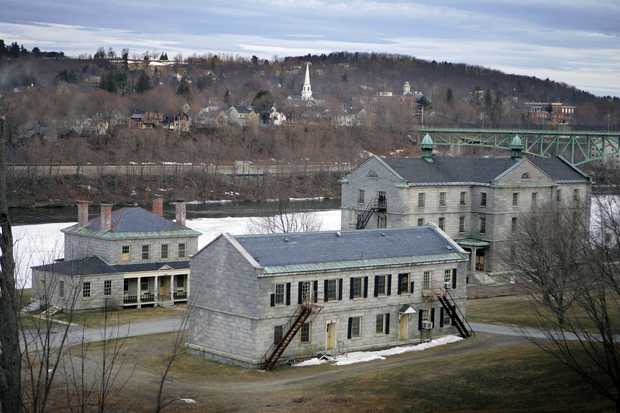
The Kennebec Arsenal compound in the early years, above, and the arsenal today. (mainepreservation photos)
by Mary Grow
Augusta Part 3
The previous articles in this series on historic places talked about some early Augusta sites and buildings. Two more, besides the Cushnoc Archaeological site and Fort Western discussed last week, are on both the National Register of Historic Places and the list of National Historic Landmarks. They are the Kennebec Arsenal on the east bank of the Kennebec and the Blaine House on the west bank, beside the state capitol building.
The Kennebec Arsenal was built as a result of strained relations between the United States and Britain, which peaked in the War of 1812 (June 1812 – February 1815); and of later border disputes between the State of Maine and the abutting Canadian province of New Brunswick, which peaked in the Aroostook War (1838-1839).
During the War of 1812, British warships repeatedly attacked Maine. The British seized Fort Sullivan, in Eastport, (built in 1808-1809) in July 1814, capturing 65 soldiers. (This writer has found no suggestions why the fort was named Sullivan. Perhaps after New Hampshire’s Revolutionary War General and later state Governor John Sullivan [Dec. 17, 1740 – Jan. 23, 1795]?)
In September 1814, British General John Coape Sherbrooke led the Penobscot Expedition. With 3,000 troops from Halifax, he defeated American forces as far up the Penobscot River as Hampden and Bangor, and seized Machias.
Following this success, the British renamed the Machias fort Fort Sherbrooke and held Castine and the territory east until the war ended. They called the area New Ireland. The February 1815 Treaty of Ghent returned the area to the United States, although disputes over islands near the border continued and, Wikipedia says, Eastport was not returned to the United States until June 30, 1818.
The Wikipedia article adds that the departing British took back to Halifax 10,750 pounds that Castine had accumulated from tariffs and used the money to found Dalhousie University.
The end of the war did not settle the border between the United States and the Canadian province of New Brunswick. There were arguments over what is now northern Aroostook County and southern Madawaska County, as settlers from both sides moved into the area.
Consequently, in 1827 the federal government developed plans for a major arsenal in Augusta, on a site south of Fort Western accessible by ocean-going ships. The arsenal was built between 1828 and 1838.
Wikipedia says the original, mostly granite buildings, built between 1828 and 1831, were “commandant’s and officer quarters, barracks, stables, a carriage shop, and the main armory.” By 1838, the commandant’s building was enlarged and redesigned in Greek Revival style, and two magazines, a munitions laboratory, an office, a wooden stable and a granite and iron perimeter fence were completed. Other sources list buildings differently, but it is clear there were at least eight early granite buildings.
In 1838, Maine and New Brunswick sent soldiers to their common border. United States General Winfield Scott came to the Kennebec Arsenal to negotiate with his friend John Harvey, then Lieutenant-Governor of New Brunswick. The two agreed to recall the respective militias and the dispute cooled.
In August 1842 the Webster-Ashburton Treaty established the boundary between the United States and Canada that exists today, including the Maine-New Brunswick line that runs along the Saint John and Saint Francis rivers. (Webster was Daniel Webster from New Hampshire, at that time United States Secretary of State; he is also known for his role in negotiating the Compromise of 1850. Ashburton was Alexander Baring, First Baron Ashburton, a British financier and diplomat.)
After Maine became less significant in international affairs, the arsenal became less vital. Wikipedia says the government made weapons in it during the Mexican War (1846-1848) and the Civil War (1861-1865); but it was too remote to be practical for major production.
The federal government closed the Arsenal, issuing the order in 1901 and finishing the process in 1903, and transferred the property to the State of Maine, owner of the Maine Insane Hospital (later the Augusta Mental Health Institute [AMHI]). The mental hospital was established by legislation in 1834 and the first buildings were completed in 1840, adjoining the Arsenal grounds on the south.
By the early 20th century, the state needed more hospital beds. Beginning in 1905, the wooden buildings on the Arsenal grounds were demolished and the granite buildings were redone and integrated into the hospital.
An on-line site describes the building called the “Old Max,” designed by Lewiston architects Coombs and Gibbs and added at the eastern side of the grounds in 1907-1909. Four stories high, built of granite and brick and designed to harmonize with the earlier Arsenal buildings, it was for maximum security patients, those too dangerous for the hospital and too mentally ill for prison.
Beginning in the early 1970s, Maine and other states moved to a new model of mental health care that minimized confinement in institutions. State officials debated what to do with the formal Arsenal/hospital. The Old Max became a state office building.
The Kennebec Arsenal was listed on the National Register of Historic Places in August 1970 and as a National Historic Landmark in February 2000.
In 2004 Save America’s Treasures, a National Park Service grant program, provided funds that state officials used for work on the granite wall and iron and granite fence around part of the original Arsenal property.
Three years later, the state sold the Arsenal property to a private company. A contemporary description lists eight major buildings on the property, plus the fence and gate, retaining walls and a wharf. Wikipedia says there are six buildings.
Conditions of the 2007 sale included a requirement that the new owner preserve and maintain the property. However, the owner let the Arsenal deteriorate to the point where in 2013 Maine sued to force the company to return the property. The owner did some work and promised more, Wikipedia says; but by 2013, the Arsenal was listed as a critically endangered historic landmark.
Contemporary photos of the Arsenal show clearly the light-colored interlocking granite blocks. An on-line site describes it as “one of the best and earliest surviving examples” of a 19th-century federal munitions depot.
Other descriptions feature deterioration, vandalism and graffiti.
Judging from two recent letters to the editor in the Central Maine newspapers, there has been no improvement. In December 2020, a Manchester resident referred to proposals to renovate the Arsenal for commercial or residential space and mourned the failure of city, county and state governments to act.
A second writer echoed the concerns in January 2021and extended them to the entire AMHI site. He called it a “historic gem” that should be preserved as representative of an important part of social and medical history.
The Blaine House, also called the James G. Blaine House, is the fourth Augusta property that is designated both a Historic Place and a Historic Landmark. It is part of Augusta’s Capital Complex Historic District. The Capitol building and Capital Park are also part of the complex and additionally have individual Historic Places listings.
The house stands at 192 State Street, just north of the Capitol building. It is named for James G. Blaine (1830-1893), whose life was summarized earlier in this series (see The Town Line, Aug. 20, 2020).
The Blaine House was originally a Federal style mansion, built in 1833 by a retired mariner, Captain James Hall. In 1862, Blaine bought it as a gift for his wife, the former Harriet Stanwood.
In the 1870s, Blaine had the original building remodeled and enlarged, making it Victorian and Italian in style and putting an addition on the west (back) side. The house remained in the family until 1919; Wikipedia says it housed the state Committee for Public Safety during World War I.
James and Harriet Blaine had seven children. When Harriet Blaine died in 1903, she left the house to three surviving children and two grandsons. The youngest daughter, Harriet Blaine Beale (1871-1958), had a son, Walker Blaine Beale, for whom his father, Truxton Beale, bought out the other heirs.
Walker Beale was killed in France in World War I, and his share of the house returned to his parents. Truxton Beale gave his share to Harriet, by then his ex-wife, making her sole owner.
In 1919, Harriet Blaine Beale donated the house to the State of Maine in memory of her son, specifying it was to be used as the Governor’s house. She became a writer, publishing children’s books and editing a collection of her mother’s letters. She died at her New York City home and is buried in Bar Harbor.
The legislature in 1919 accepted the gift and the condition. Maine architect John Calvin Stevens remodeled the building in neo-Colonial style, and in 1921 Carl Milliken became the first governor to live there. Most of his successors have also chosen to live in the historic house.
Governors have used the house to entertain famous guests, including President Ulysses Grant, advocate for the blind Helen Keller and aviator Amelia Earhart. An on-line source says some chief executives used it to promote Maine; for example, Governor Louis Brann, who served from January 1933 to January 1937, attracted large crowds to his celebrations of Maine Summer Visitors’ Day.
The Blaine House was listed as a National Historic Landmark in 1964 and added to the National Register of Historic Places in 1966. In 1989, Governor John McKernan started a restoration program that included creation of Friends of the Blaine House, a nonprofit organization that helps the state fund building maintenance. Friends of the Blaine House has a website, www.blainehouse.org, with information about the building, the organization, the gift shop and tours.
Wikipedia says in 2014 heat pumps were installed to reduce the horrendous heating bill.
When current Governor Janet Mills opened the annual Christmas light display on the building on Dec. 11, 2020, she called it “a Celebration of Resilience.”
Interesting links
Here are some interesting links for you! Enjoy your stay :)Site Map
- Issue for April 25, 2024
- Issue for April 18, 2024
- Issue for April 11, 2024
- Issue for April 4, 2024
- Issue for March 28, 2024
- Issue for March 21, 2024
- Issue for March 14, 2024
- Issue for March 7, 2024
- Issue for February 29, 2024
- Issue for February 22, 2024
- Issue for February 15, 2024
- Issue for February 8, 2024
- Issue for February 1, 2024
- Issue for January 25, 2024
- Issue for January 18, 2024
- Issue for January 11, 2024
- Issue for January 4, 2024
- Issue for December 21, 2023
- Issue for December 14, 2023
- Issue for December 7, 2023
- Issue for November 30, 2023
- Issue for November 23, 2023
- Issue for November 16, 2023
- Issue for November 9, 2023
- Issue for November 2, 2023
- Sections
- Our Town’s Services
- Classifieds
- About Us
- Original Columnists
- Community Commentary
- The Best View
- Eric’s Tech Talk
- The Frugal Mainer
- Garden Works
- Give Us Your Best Shot!
- Growing Your Business
- INside the OUTside
- I’m Just Curious
- Maine Memories
- Mary Grow’s community reporting
- Messing About in the Maine Woods
- The Money Minute
- Pages in Time
- Review Potpourri
- Scores & Outdoors
- Small Space Gardening
- Student Writers’ Program
- Solon & Beyond
- Tim’s Tunes
- Veterans Corner
- Donate




